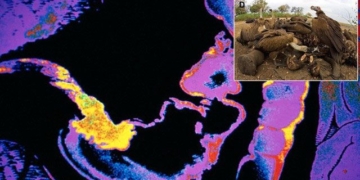On April 11, the National Scientific and Technical Research Council of Argentina (Conicet) announced that the country’s paleontologists have discovered a new dinosaur species belonging to the titanosaur genus, a group of large, herbivorous sauropods with small heads.
According to a statement from Conicet reported by journalists in Buenos Aires, this new dinosaur species lived in the Patagonia region of Argentina approximately 66 million years ago, just before the Cretaceous-Paleogene extinction event that marked the end of the “reign” of dinosaurs on Earth.

The new dinosaur species is called Titanomachya gimenezi. (Photo: news.nationalgeographic.org).
Argentinian scientists have named the newly discovered species “Titanomachya gimenezi”, a name that evokes the Titanomachy battle in Greek mythology, where the gods fought against the Titan giants. Additionally, the name honors Olga Giménez, the first paleontologist to discover dinosaur fossils in the Chubut province of southern Argentina.
Researcher Agustín Pérez Moreno from Conicet stated that the fossils of this new titanosaur species were found in thick sedimentary layers in the “La Colonia Formation” in Chubut province.
The “Titanomachya gimenezi” weighs about 7 tons, significantly smaller than the “Patagotitan mayorum”, which also belongs to the titanosaur genus and lived approximately 95 to 100 million years ago in Patagonia. Fossils of “Patagotitan mayorum” were first discovered in Neuquén province, indicating that this titanosaur could weigh up to 70 tons, measure 37 meters long, and stand nearly 6 meters tall.
In the case of “Titanomachya gimenezi,” Argentinian paleontologists identified the existence of this species based on the morphology of the pedal bones, a type of bone found in the hind limbs of dinosaurs. The researchers successfully recovered parts of the forelimbs and hind limbs, as well as rib fragments and vertebrae from the tail of this species.
Pérez Moreno emphasized that prior to the discovery of “Titanomachya gimenezi,” scientists had never found any fossils of sauropod dinosaurs in the “La Colonia Formation”—which is considered a “graveyard” for many ancient species, ranging from carnivorous dinosaurs and snake-headed lizards to turtles and other reptiles.
Therefore, this scientist asserted that “findings in La Colonia not only provide important information about the sauropod population in Patagonia at the end of the Cretaceous but also about the diversity of the ecosystem in the region at that time.”
About 66 million years ago, the ecosystem in the humid Patagonia region featured aquatic flora, palm trees, and diverse coniferous forests, creating an ideal habitat for large herbivorous dinosaurs.


















































